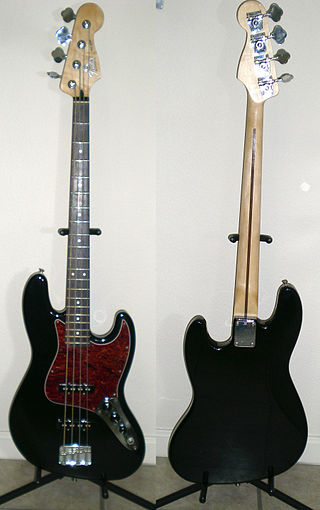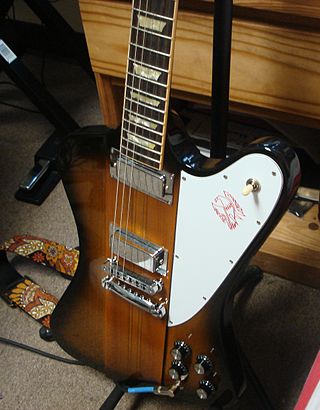
The Fender Jazzmaster is an electric guitar designed as a more expensive sibling of the Fender Stratocaster. First introduced at the 1958 NAMM Convention, it was initially marketed to jazz guitarists, but found favor among surf rock guitarists in the early 1960s. Its appearance is similar to the Fender Jaguar, though it is tonally and physically different in many technical ways, including pickup design, scale length and controls.
The Fender Jaguar is an electric guitar by Fender Musical Instruments characterized by an offset-waist body, a relatively unusual switching system with two separate circuits for lead and rhythm, and a short-scale 24" neck. Owing some roots to the Jazzmaster, it was introduced in 1962 as Fender's feature-laden top-of-the-line model, designed to lure players from Gibson. During its initial 13-year production run, the Jaguar did not sell as well as the less expensive Stratocaster and Telecaster, and achieved its most noticeable popularity in the surf music scene. After the Jaguar was taken out of production in 1975, vintage Jaguars became popular first with American punk rock players, and then more so during the alternative rock, shoegazing and indie rock movements of the 1980s and 1990s. Fender began making a version in Japan in the mid-1980s, and then introduced a USA-made reissue in 1999. Since then, Fender has made a variety of Jaguars in America, Mexico, Indonesia and China under both the Fender and Squier labels. Original vintage Jaguars sell for many times their original price.

The Fender Precision Bass is a model of electric bass guitar manufactured by Fender Musical Instruments Corporation. In its standard, post-1957 configuration, the Precision Bass is a solid body, four-stringed instrument usually equipped with a single split-coil humbucking pickup and a one-piece, 20-fret maple neck with rosewood or maple fingerboard.

The Fender Jazz Bass is the second model of electric bass created by Leo Fender. It is distinct from the Precision Bass in that its tone is brighter and richer in the midrange and treble with less emphasis on the fundamental frequency. The body shape is also different from the Precision Bass, in that the Precision Bass has a symmetrical lower bout on the body, designed after the Telecaster and Stratocaster lines of guitars, while the Jazz Bass has an offset lower bout, mimicking the design aesthetic of the Jaguar and Jazzmaster guitars.

The Fender Cyclone denotes a series of electric guitars made by Fender. Introduced in late 1997, the Cyclone body is similarly styled to the Mustang, but it is a quarter of an inch thicker than the body of a Mustang and is made of poplar, whereas contemporary Mustang reissues were made of basswood.

The Gibson Firebird is a solid-body electric guitar manufactured by Gibson beginning in 1963.
The Fender Bass VI, originally known as the Fender VI, is a six-string electric bass guitar made by Fender.

The Fender Mustang is a solid body electric guitar produced by the Fender Musical Instruments Corporation. It was introduced in 1964 as the basis of a major redesign of Fender's student models, the Musicmaster and Duo-Sonic. It was produced until 1982 and reissued in 1990.
The Fender Toronado was an electric guitar made by Fender Musical Instruments Corporation. Introduced at the NAMM Show in 1998, it is a part of the "Deluxe Series" of Fenders produced in Mexico, generally to higher specs than most "Standard" models.

The Fender Esquire was a solid-body electric guitar manufactured by the Fender Musical Instruments Corporation of Los Angeles. It was the first solid-bodied guitar marketed by the company, and made its debut in 1950.
The Fender Lead Series was produced by the Fender/Rogers/Rhodes Division of CBS Musical Instruments. The series comprised Lead I, Lead II, Lead III and Lead Bass models.

The Squier '51 is an electric guitar made by Squier, a brand of Fender. The '51 is notable for being one of the few original designs made by Squier, which normally sells budget versions of Fender's popular guitars and bass guitars.

The Fender Jaguar Bass is an electric bass guitar currently manufactured in Mexico by the Fender Musical Instruments Corporation.
The Fender Katana is an electric guitar built by Fender. It was designed by marketing director Dan Smith in 1985. The Katana was designed to compete with the unconventionally-shaped guitars of the era, such as the Jackson Randy Rhoads, and to satisfy Fender dealers who were suffering from the competition those instruments offered. The Katana did not sell as well as Fender hoped, and it was discontinued in 1986 before being reissued as a Masterbuilt Custom Shop model as part of the Prestige collection three decades later.
The Fender Telecaster Thinline is a semi-hollow guitar made by the Fender company. It is a Telecaster with body cavities. Designed by German luthier Roger Rossmeisl in 1968, it was introduced in 1969 and updated in 1972 by replacing the standard Telecaster pickups with a pair of Fender Wide Range humbucking pickups, bullet truss-rod and 3-bolt neck.
The Fender Bullet was an electric guitar originally designed by John Page and manufactured and marketed by the Fender Musical Instruments Corporation. It was first introduced as a line of "student" guitars to replace the outgoing Mustang and Musicmaster models.

The Fender J5 Telecaster is John 5's signature model Telecaster, and was designed in part by John 5 himself. The prototype built by Fender Custom Shop Artist Relations representative Alex Perez has served as John 5's main guitar since around 2003. The standard features that differentiate John 5's Telecasters from the traditional Telecaster design include dual volume controls instead of both a volume and tone control, a three-way toggle switch mounted through the upper bout, chrome pickguard, and a specially shaped headstock.
Fender California Series electric guitars were produced by Fender in 1997 and 1998. The guitars were carved in California, shipped to Baja California Norte, Ensenada, Mexico for painting, then assembled in California.
The Fender Telecaster, colloquially known as the Tele, is an electric guitar produced by Fender. Together with its sister model the Esquire, it was the world's first mass-produced, commercially successful solid-body electric guitar. Its simple yet effective design and revolutionary sound broke ground and set trends in electric guitar manufacturing and popular music. Many prominent rock musicians have been associated with the Telecaster for use in studio recording and live performances, most notably Bruce Springsteen, Luis Alberto Spinetta, Keith Richards and George Harrison.

The Fender Cabronita Telecaster is a class of guitars built by Fender Musical Instruments Corporation based on their Telecaster body shape. The name Cabronita is Spanish slang and roughly translates as little bastard or little devil. While retaining the shape and general feel of a Telecaster, they are a radical departure from the traditional electronics and sounds associated with the instrument. Like virtually all Telecaster submodels, they are labeled simply as a Fender Telecaster on the headstock logo, identifiable only by their features.














